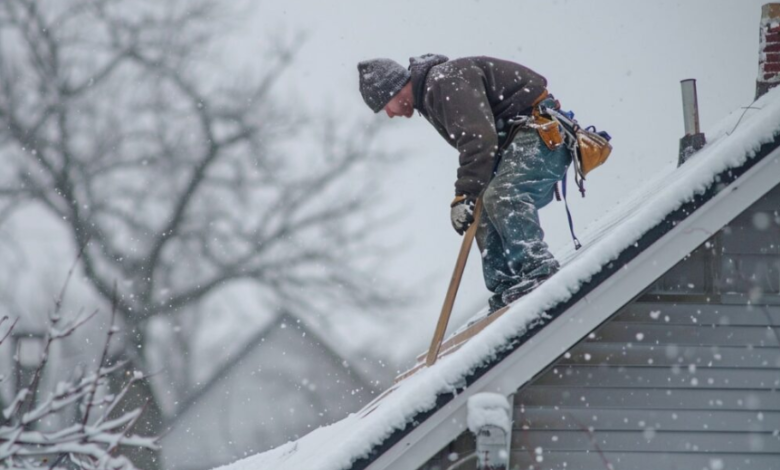How to Protect Your Roof From Ice Dams and Heavy Snow This Winter

Winter roof protection in Calgary is about arming your roof for deep freezes, Chinook swings, and heavy snow and ice. Calgary houses and businesses are at risk from ice dams, wind uplift, clogged vents, and melt-refreeze leaks. Get your winter roof protection in Calgary with proper attic insulation, sealed vapour barriers, and balanced ventilation. Eaves protection and snow load checks reduce risk. Ice-melt systems and rapid snow clearing aid flat and steep roofs. Superior Roofing Ltd. provides on-site inspections and repairs tailored to Calgary codes, climate, and construction styles to keep roofs protected.
Calgary’s Unique Winter Roof Threats
Calgary’s winter swings hard and fast. Roofs are under siege from freeze-thaw stress, heavy snow, hail, and wind. The combination reduces life expectancy if not countered with good design, materials, and maintenance.
- Freeze-thaw cycles
Day melts and night freezes, forcing water into small cracks and then enlarging them. Shingles can crack, lose granules, and curl. Slate can shear at nail holes. Flat roofs develop blisters and splits in the membrane at laps and seams. These cycles are common in our area and contribute to ice dams along eaves, where water pools and leaks. Well-insulated attics and balanced ventilation reduce melting and keep the deck cold, slowing damming.
- Ice dams, icicles, and gutter risks
Calgary’s Unique Winter Roof Threats: Snow melts due to heat loss, runs to cold eaves, then freezes and blocks the flow. Water backs up under shingles and discovers joints, valleys, and old flashing. Calgary’s unique winter roof dangers include clogged gutters that freeze solid, adding weight and creating large icicles that can harm pets and sidewalk walkers, as well as bend gutters. Raking snow near eaves, opening gutters, using heat cables in known trouble spots, and sealing air leaks in the attic minimize the chances of damage.
- Heavy snow load
Storms can accumulate quickly. On flat roofs, drifts form behind ridges, parapets and HVAC curbs. Excess load stresses trusses, fasteners and parapet joints. Design and maintenance need to be comparable to local snow loads. Clear drifted sections first, keep drains and scuppers open, and prevent membrane punctures and edge damage with trained crews.
- Hail and high winds
Spring and winter hail slams us here. Large hail can bruise shingles, dent soft metals and fracture older tiles. High winds lift edges and expose fasteners on metal and peel seams on flat systems. Choose Class 4 impact-resistant shingles, rubber roofs, or thicker-gauge metal with high-wind fastening. Plan post-storm inspections to spot early damage.
- Aging flashing
Extreme cold and sun cycles corrode and crack flashing at walls, chimneys, and vents. Tiny cracks turn into leak channels. Inspect and re-seal these spots before deep winter.
Your Pre-Winter Roof Protection Plan
Calgary winters deliver deep cold, heavy snow and lightning-fast chinook swings. Your Pre-Winter Roof Protection Plan is a focused plan that reduces risk, controls costs and keeps roofs in service through freeze-thaw cycles.
See also: How Small Changes at Home Can Build a More Energy-Efficient Future
Schedule comprehensive roof inspections to detect damaged shingles, weak roof structures, and inadequate roof insulation before winter hits.
Schedule a comprehensive roof and attic inspection for early fall. Look for cracked or missing shingles, loose flashings at the valleys, walls and chimneys, punctures on flat roofs and soft sheathing at the eaves. Check your truss connections, load paths, and ceiling stains for signs of silent leaks. In the attic, measure the insulation depth, look for wind wash at the eaves, and test the bath fan terminations for the exterior. Routine inspections detect vulnerable areas before those harrowing snow loads materialize, enabling prompt repairs.
Install snow guards, heat cables, and ensure proper attic ventilation to prevent ice dam formation and uneven roof surface temperatures.
On steep-slope roofs, install snow guards above doors, walks and gas meters to mitigate the risk of a slide. Install self-regulating heat cables at eaves and those pesky problem valleys where ice dams form. Balance attic intake at soffits with ridge or high vents to even roof deck temperatures and exhaust moist air. Proper ventilation and insulation, when combined, reduce condensation and ice dams.
Reinforce vulnerable areas with high-quality roofing materials, such as impact-resistant asphalt shingles or metal roofing, for enhanced winter protection.
Get ahead of hail and freeze season with Class 3 or 4 impact-rated asphalt shingles or standing seam metal. On flat roofs, install quality SBS or PVC membranes with welded seams. Add ice and water shield to eaves, rakes, valleys and low-slope tie-ins. Substitute thin flashings with heavier-gauge metal and seal fasteners with cold-rated sealants.
Create a comprehensive checklist with detailed descriptions to ensure all essential maintenance tasks are completed before the winter season.
- Clean up gutters, downspouts, and scuppers, ensuring that tight slopes are in place and that discharge is directed away from foundations.
- Top up attic insulation and air seal penetrations. This can reduce heating bills by 30-40%.
- Stock roof rakes, snow shovels, and de-icers before storms.
- Schedule snow clearing after heavy events. Clear when the accumulation approaches 30 cm or more.
- Identify roof hazards, service routes, and anchor points for safe entry.
The Role of Insulation and Ventilation
Calgary’s freeze-thaw cycle puts a significant amount of stress on roofs. Insulation and ventilation stabilize roof temperatures, reduce heat loss, and minimize ice dams, preserving shingles, membranes, and decks while increasing comfort and air quality.
Upgrade attic insulation and roof ventilation systems to maintain uniform roof temperatures, reducing the risk of ice dams and heat loss.
Insulation resists heat transferring from the living space into the attic, while ventilation pushes cold, dry outdoor air into the attic to flush heat and moisture outside. Combined, they maintain consistent roof deck temperatures, reducing eave ice dam potential and lowering energy consumption by up to 30%. In Calgary, attic bypasses occur around pot lights, bath fans, and chimney chases. Seal these first, then insulate and ensure clear soffit intake with baffles to prevent vents from getting blocked by batts or blown-in fill.
Types of insulation and their effectiveness
| Insulation Type | Typical Application | Pros | Considerations |
| Fiberglass batts | Between joists/rafters | Cost-effective, easy to place | Needs air sealing, can sag if compressed |
| Blown-in cellulose | Attic floors | Good coverage, fire-treated | Needs depth markers, can settle slightly |
| Blown-in fiberglass | Attic floors | Stable R-value, low settling | Requires proper netting in slopes |
| Spray foam (closed-cell) | Sloped roofs, tricky areas | Air + vapour control, high R/inch | Higher cost, needs pro install |
| Rigid foam boards | Knee walls, exterior | Continuous layer, thermal break | Detailing at seams is key |
Ensure proper attic ventilation rates to prevent moisture buildup, mould growth, and premature deterioration of roofing components.
Aim for balanced intake and exhaust. For most Calgary attics, follow a net free area ratio of one to three hundred (total vent area to attic area), increased to one to one hundred fifty if air sealing is poor. Always use continuous soffit intake with ridge vents where you can. On low-slope or complex roofs, complement the soffit with high-quality roof louvres. Well-ventilated attic spaces help prevent condensation and mould as well as deck rot and keep homes cooler in the summer.
Evaluate insulation layers and natural roof ventilation to extend roof life and improve overall home comfort during harsh Calgary winters.
Inspect the insulation depth and coverage at the eaves, as well as around hatches. Check that bath and kitchen fans vent outside, not in the attic. Install baffles at each open soffit bay. Insulation and ventilation are your best allies against ice dams. They trim your bills and help minimize health risks from mould, and keep your structure intact by stabilizing indoor temperatures.
Safely Handling Snow and Ice
Calgary’s freeze-thaw swings put roofs through the wringer. Safe snow and ice control safeguards shingles, membranes, eaves, and people by reducing the potential for leaks and the load on the structure.
- Try to use a roof rake from the ground. Shovel to the ground, which is 1.2 meters, after big dumps to reduce weight and prevent ice dams.
- Clear gutters to drain meltwater. Sprinkle in heated gutter cables or snow-prevention netting exactly where eaves freeze up first.
- Shovel small quantities frequently. Easy, frequent passes win over hard, dangerous shovelling.
- Don’t chip ice with metal tools. They slice shingles and pierce flat-roof membranes.
- On solid, dry earth, place the ladder with a stabilizer and spotter.
- Use boots with grip, insulated gloves, and a CSA-rated hard hat. Use a fall-arrest system on any roof access.
- Mark and avoid rooftop gas lines, vents, skylights, and solar arrays. Keep rake heads and shovels clear of them.
- Cut back branches overhanging eaves. They snap beneath wet snow, tearing up shingles and gutters.
- Stage tools before storms: roof rakes, plastic shovels, calcium chloride socks for ice and de-icing products fit for roofing.
- Conduct a fall inspection to identify weak seams, loose flashings, soft decking, and clogged roof drains.
Use secure ice dam removal when thick ridges of ice form along eaves. Steam is the norm because it melts ice without ripping shingles or rolls. In Calgary, employ an ice dam removal company that uses commercial steamers, roof protection boards, and carefully controlled runoff to prevent refreezing on walkways. Keep salt pellets off shingles and torch work; these both shorten roof life and void many warranties. Inside, watch for water at ceilings adjacent to exterior walls, discoloured drywall, or drips at window heads—early indicators of damming.
Heavy snow and ice pile on weight that can flex trusses, pop open joints, and incite leaks, and in extreme instances, collapse. Be alert for signs like doors sticking, sagging ceilings, or cracking sounds, and call in a professional if they appear. Icicles seem innocuous, but they indicate clogged eaves and trapped water at the edge.
The Hidden Cost of Neglect
Calgary’s winter punishes weak roofs. Neglect is expensive. Ignoring upkeep turns little fixes into big, costly jobs, and it tends to rear its ugly head when it’s coldest and hardest to fix.
Water Damage, Sagging, and Structure
Melt-freeze cycles push water beneath shingles and flashings. A tiny drip can now cause drywall stains, subfloor twisting, and mould by spring. One missed leak can result in thousands of dollars’ worth of secret infiltration and interior repairs the following season. It’s heavy snow, ice buildup, and wind uplift that stress trusses and fasteners with ice dams weighing as much as 700 kilograms that pry gutters, split shingles, and load the eaves until ceilings sag. Hail and chinook winds deposit visible and invisible destruction that multiplies with every storm.
Insurance Gaps from Poor Maintenance
Many Alberta policies will restrict compensation if damage arises from negligence. Insurers will frequently deny or reduce claims associated with issues such as worn flashings, clogged eavestroughs, or improper snow removal that breaks seals. Documented annual or semiannual inspections, maintenance logs, and photos help demonstrate due care and keep coverage intact.
Energy Waste and Comfort Loss
Poor insulation and weak air sealing contribute to heat loss during cold snaps. Warm air leaks feed ice dams and inflate gas bills. Upgrading attic insulation and ventilation can save you up to 30% on heating costs, while timely leak repairs stop wet insulation from losing R-value and prevent frost in the attic.
Long-Term Consequences at a Glance
- Shorter roof life; routine care can add 20–30 years
- Higher energy bills from heat loss and wet insulation
- Mould, rot, and sagging from chronic moisture
- Moss growth that holds water and rots shingles
- Gutter and downspout failure from ice weight
- Claim disputes and out‑of‑pocket repairs
- Escalating costs amid material and labour price swings
Proactive Steps That Pay Off
Book annual or semiannual roof inspections pre- and post-winter. Clear eavestroughs, check flashings, seal penetrations, and safely reduce snow loads in high-drift areas. Treat hail hits and lifted shingles quickly. These habits prevent small problems from escalating into major repairs and help stabilize expenses when renovation costs surge due to supply, production, or labour shortages.
When to Call a Professional
Calgary’s freeze-thaw cycles, chinooks, and high winds create roof risks that can be hazardous—knowing when to call in a professional.
Request a comprehensive roof inspection if you notice signs of roof leaks, damaged shingles, or excessive snow accumulation on your roof.
Call immediately if you detect water stains on the ceiling, moist attic insulation, or frost on the roof deck. Stuck doors, creaks or pops from above, and new cracks in drywall indicate structural stress from snow load. Loose, curled or missing shingles following a wind event require immediate evaluation. Semi-annual inspections in spring and fall are a good idea. If you experience a change in mid-winter, schedule an inspection. Professionals have the equipment and ice-safe techniques to work in cold.
Hire licensed roofers for full roof replacement, flat roofing repair, or installation of advanced winter protection products.
Employ certified crews for re-roofs, membrane repairs on flat or low-slope systems and upgrades, such as ice and water shield, self-regulating heat cables and high-wind-rated shingles. Licensed roofers handle permits, safety, and manufacturer specifications, which preserve warranties and enable proper cold-weather installation.
Seek professional advice for choosing the right roofing material, insulation upgrades, and effective snow management solutions tailored to Calgary’s winter hazards.
Inquire about Chinook swing-rated shingle types, SBS-modified membranes for flats, and adequate attic insulation and air sealing to reduce ice dam hazards. Properly size and install snow guards, plan safe snow removal strategies, and design heat cable layouts where necessary. They establish snow clearance thresholds to alleviate loads.
It is recommended to hire professionals for winter work, including snow removal, ice dam removal, wind damage repair, and animal intrusion prevention.
Heavy snow can stress framing, so call to have it safely removed. Ice dams require professional steaming to halt leaks without shingle harm. Wind-torn shingles and exposed nails need urgent attention. If you hear animals or see nesting, that’s the time to call in the pros to plug up entry points and repair chewed materials.
| Service | Typical Scope | Estimated Cost (CAD) |
| Winter roof inspection | Full visual + attic check | $200–$450 |
| Snow/ice removal | Per visit, roof-only | $300–$900 |
| Ice dam steaming | Per hour or section | $400–$1,200 |
| Shingle repair (wind) | Small area patch | $350–$1,000 |
| Flat roof leak repair | Membrane patch/seam | $500–$2,000 |
| Heat cable install | Per linear metre | $35–$70/m |
| Full shingle replacement | Avg. Calgary home | $8,000–$18,000+ |
Conclusion
Need assistance before the next clipper rolls in? Call Superior Roofing for a quick roof inspection, ice dam repair or snow removal. Receive a reasonable estimate, honest communication and quality craftsmanship. Curious to check out our licenses, safety badges, and reviews? Visit our About page for all our trust credentials.




